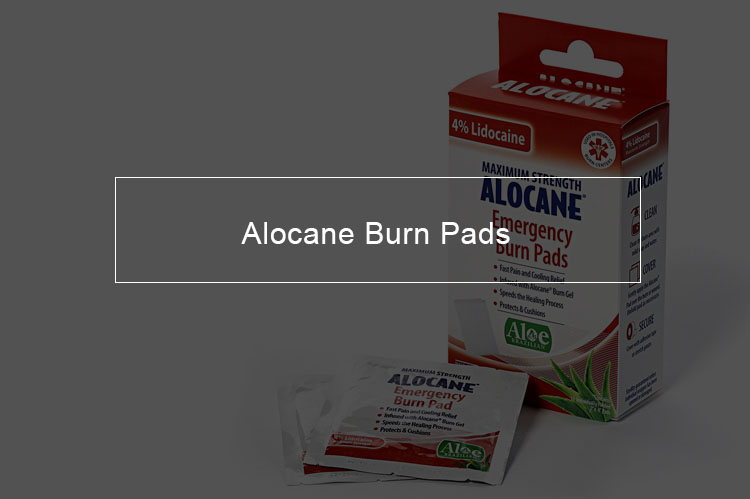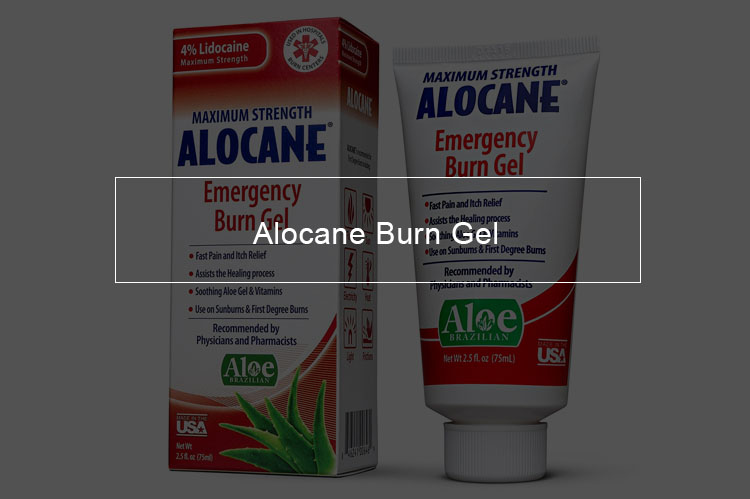
Burns sends most of the people in the United States to the hospital yearly; not to mention the countless burns treated in smaller clinics or at home. Learning how to identify burns, treating them faster, and keeping infection at control are critical factors in speeding up the healing process. This article has covered tips of treating minor burns at home with a particular focus on alcone burn pads.
Is Alocane good for burns?
Alocane for burns
Minor first-degree and most of the second-degree burns can be treated faster and effectively in the home if you have the right products and follow the first aid process properly. There are many medications used to treat minor burns, but in this section, we will focus on Alocane. This medication is applied to the skin to prevent itching and stop pain from skin burn.
How to use Alocane for minor burns?
Before use Alocane to treat a burn, clean, and dry the affected area. Run the burned skin under cool until the heat of the burn has dissipated or for ten to fifteen minutes. Running water does not only help cool the burn, but it also helps remove any debris or irritants that could prevent the burn from healing well. Let the skin dry and do not apply ice to the burn.
- Apply a thin layer of Alocane to the affected area of skin, typically two to three times a day.
- Do not use alocane on raw skin or blisters.
- In case you are using the spray, shake the canister properly before using. Hold the canister three to five inches from the affected region, spray until wet. If the affected region is on the face, spray the alocane onto your hand and apply to the face. Avoid spraying near the nose, eyes, or mouth.
- In case you are using the foam, shake the canister properly before using it. Spray the foam onto your hard and apply to the affected area.
- Do not use the ointment on large areas of the body, seal the area with waterproof bandages or plastic, or apply heat not unless advised to do so by your doctor; these might increase the threat of severe side effects.
- Not unless you are treating an area that is on the hands, wash hands immediately after using alone. Avoid getting Alocane in eyes, ears, or nose. In case the medication gets in these areas, wash off the area immediately with clean water.
- Gently apply a loose, sterile bandage to protect the skin from further irritation, which could delay healing. Be sure to change the gauze as many times as necessarily.
- Re-apply Alocane as required, but no more than three or four times a day.
- Alocane dosage is based on the medical state and reaction to therapy. Do not use the product beyond the period recommended by a doctor. If you are using non prescribed product, follow all the directions on the product package, or use as direct by the pharmacists or doctor. If there is an infection or a sore in the region to be treated, do not use this medication without consulting your physician first.
Side effects of alocane burn gel
- Alocane gel can cause temporary redness, stinging, and a little of inflammation might occur at the application of the gel. If these side effects signs persist or worsen, visit a doctor immediately.
- However, note that the doctor has prescribed this medication since he judged the benefits to the risks associated with the medicines. It is worth noting that most people who use this medication do not get severe side effects.
- Visit a doctor if you have any signs of severe side effects inclusive of; slow breathing, pale skin, unusual tiredness, and irregular heartbeat.
- Severe allergic reaction to this medication is rare. Nevertheless, seek medical attention if you notice any of the following signs a worsening rash, dizziness, difficulty in breathing, worsening itch, and swelling.
- Before using Alocane, inform your physician if you are allergic to the medications or if you have any other allergies. Alocane may have inactive ingredients, which can lead to allergic reactions or other problems. Talk to your doctor for more details.
- Before using this treatment, inform your doctor or your pharmacist your medical history, especially of: heart disease, liver, or blood disorder.
- Caution is required when using this medication in children because they may be more sensitive to the side effects of the drug.
- During pregnancy, use, Alcone medication only when. Discuss the threats and benefits with your doctor.
- This medication penetrates breast milk but is unlikely to harm a nursing infant. Consult your doctor before breastfeeding.
How does burn gel work?

Burn emergency burn gel
A burn gel is a first aid product for the treatment of mild burns, scalds, and various types of abrasions and friction injuries. Depending on the manufacturer, you might find the burn gel being called different names. When treating burns, always follow the standard first aid process for burns such as immediately cooling the area, and if you have a doubt, seek medical attention.
Hydrogen burns come in three forms:
- Amorphous hydrogel; this is a free-flowing burning gel, which is packed in tubes, spray bottles, and foil packets.
- Impregnated hydrogel; this is an amorphous hydrogel saturated onto gauze pad, non-woven sponge ropes.
- Sheet hydrogel; a gel characterized by a thin fiber mesh. This dressing can overlap intact skin and basically will not destroy it. It is accessible with and without adhesive borders and can be cut to fit the wound.
The most type of burn gel absorbs bacteria. They are waterproof, breathable, and skin-friendly, and their removal should not irritate the wound. By offering moisture to the burn wound, burn gel create a moist healing environment.
For a minor burn, the ones you do not need medical attention, you can opt to use a hydrogel barrier in one of the kinds of burn gel or burn plaster above to provide pain relief and minimize risk infection. Hydrogel plasters rather than dressings are especially suitable for the treatment of smaller superficial burns.
Is Lidocaine good for burns?
Lidocaine burn gel
Lidocaine is a local anesthetic. It functions by blocking nerve signals in the human body. Lidocaine ointment for use on the skin is used to minimize pain or discomfort caused by skin irritations such as sunburns and minor burns. Lidocaine ointment is also used to treat rectal discomfort caused by hemorrhoids.
You should not use lidocaine ointment if you are allergic to any numbing medication. Fatal overdoses had happened when numbing medicines were used without the guidance of a medical doctor. It is worth noting that many cosmetic processes are performed without a medical doctor present. To ensure that Lidocaine is safe for you, tell your doctor if you have a heart problem or liver disease.
Lidocaine ointment can harm an unborn baby. Thus you should inform your doctor if you are pregnant. Inform the doctor if you are breastfeeding even though it is not clear if Lidocaine topical passes into breast milk.
Side effects of Lidocaine on burns
- An overdose of lidocaine medicine can result in fatal side effects if too much of the medicine is absorbed through your skin.
- Do not use large amounts of lidocaine ointment, or cover treated skin regions with a bandage wrap without medical assistance.
- Keep both used and available lidocaine skin patches away from children.
- The quantity of Lidocaine in the skin patches could be harmful to a child who accidentally sucks on or swallows the patch.
How to use Lidocaine topical?
Using Lidocaine as directed on the label, or as it is has been prescribed by the doctor. Do not apply for the medicine in more significant amounts that commended. Note that misuse of lidocaine ointment can cause death. The topical comes in various forms- gel, spray, cream, lotion, ointment, and skin patch.
Do not use Lidocaine orally; it should only be used on the skin. If Lidocaine gets eyes, vagina, mouth or nose rinse it water. Use a thin layer of the medicine to apply to skin. Your body can absorb large amounts of this medication if you use large quantities, if you smear it over big skin area, or if you apply heat, bandages, or plastic cover the treated skin areas. Skin that is cut or irritated can also absorb more topical medication than healthy skin.
Do not apply this medicine to inflamed skin regions or deep puncture wounds. Do not use the medication on the skin that is blistered or raw, such as a severe burn or abrasion. Do not bandage the treated surface unless your doctor has told you to. Lidocaine topical may be applied with your fingertips or cotton. If your medicine has patient instructions for safe and effective use, follow these directions carefully. Request your doctor or pharmacist if you have any questions.
Store the medicine at room temperature; away from moisture and heat.Keep both used and unused lidocaine ointment skin patches away from children or pets. The quantity of Lidocaine in the skin patches could be harmful to a child or pet who accidentally sucks on or swallows the patch.Seek emergency medical attention if this happens.
Alocane vs minor degree burns home remedies
Burns have an increased threat of infection because they open your skin, that is your body's protective barrier against bacteria and different agents. Over generations, dozens of home remedies had been evolved for treating household burns, and they have remained because they are reasonably priced and convenient. Most of these remedies, however, soothe your pain, while a few can cause nasty complications. We accumulated some home treatments and compared them to ALOCANE Emergency Burn Gel to see if they can deal with pain, soothe skin, and promote restoration as ALOCANE can.
Ice for minor degree burn treatment
Under no circumstances should you apply ice, inclusive of ice packs or bags of frozen peas, to any form of a burn. This is the most natural—but insidious—home remedy. You can welcome the drastic change in temperature after feeling searing pain, however making use of ice to a burn can shock the already broken pores and skin. You may additionally sense temporary alleviation through numbing the area. However, rapid cooling may cause greater harm or even frostbite. Even though ice addresses pain and soothes your skin, it's going to delay the healing process due to the extra damage it can inflict to your burned pores and skin.
Honey vs. Alocane for minor degree burns treatment
The historic Egyptians used honey to treat several injuries. Even though medical-grade honey has antibacterial properties, this isn't always true of all honey—the plastic honey bear from the grocery store is not as sterile as we would hope. Many store-bought honey products also contain syrupy additives that could make removing and replacing bandages exceptionally painful. Using honey may accidentally reopen blisters or peel away recovery skin, which can lead to an infection that will hinder the healing procedure and make it more likely for scars to shape. Moreover, honey does not address pain or irritation.
Butter and other oils vs. ALOCANE as remedies for minor degree burns
Even though butter, olive, coconut, and lavender oil may moisturize your skin, they also can do unseen damage. Those oils can trap the heat of your burn, amplifying the damage as the heat burrows more profound into your skin. This is mainly real for sunburn sufferers. Many turn to the ever-popular skin care remedy of coconut oil to assist heal sun-damaged pores and skin, given its antioxidants and often-introduced vitamin E. but, oils of any kind could make it difficult in your skin to respire, and prevent recovery time. This home remedy will now not treat pain or soothe your burn (even though it is crucial to keep healing burns moisturized).




